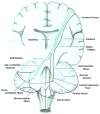The role of the cerebellum in schizophrenia
- PMID: 18395701
- PMCID: PMC3175494
- DOI: 10.1016/j.biopsych.2008.01.003
The role of the cerebellum in schizophrenia
Abstract
For many years the cerebellum has been considered to serve as a coordinator of motor function. Likewise, for many years schizophrenia has been considered to be a disease that primarily affects the cerebrum. This review summarizes recent evidence that both these views must be revised in the light of emerging evidence about cerebellar function and the mechanisms of schizophrenia. Evidence indicating that the cerebellum plays a role in higher cortical functions is summarized. Evidence indicating that cerebellar abnormalities occur in schizophrenia is also reviewed. These suggest interesting directions for future research.
Figures




References
-
- Andreasen NC, O’Leary DS, Arndt S, Cizadlo T, Rezai K, Watkins GL, et al. I. PET studies of memory: Novel and practiced free recall of complex narratives. NeuroImage. 1995;2:284–295. - PubMed
-
- Calarge C, Andreasen NC, O’Leary DS. Visualizing how one brain understands another: a PET study of theory of mind. Am J Psychiatry. 2003;160:1954–1964. - PubMed
Publication types
MeSH terms
Grants and funding
LinkOut - more resources
Full Text Sources
Medical

